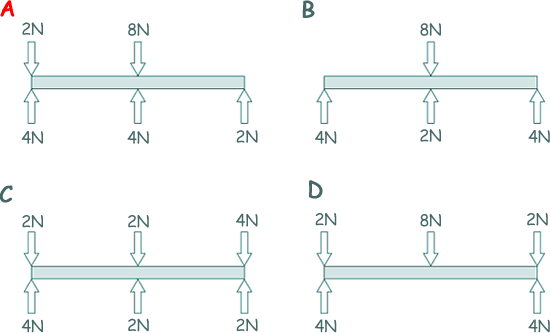Moments Q1. A light uniform rigid bar is pivoted at its centre. Forces act on the bar at its ends and at the centre.
Which diagram shows the bar in equilibrium? There are two things to consider here - moments and vertical up/down forces:
ΣUp forces = 10N ΣDown forces = 10N (so in balance)
ΣUp forces = 10N ΣDown forces = 8N (so not in balance)
ΣUp forces = 6N ΣDown forces = 8N (so in balance)
ΣUp forces = 8N ΣDown forces = 12N (so not in balance)
Q2. The diagram shows a uniform metre ruler of weight 1.5 N pivoted 15 cm from one end for use as a simple balance.
A scale pan of weight 0.5 N is placed at the end of the ruler and an object of unknown weight is placed in the pan. The ruler moves to a steady horizontal position when a weight of 2.5 N is added at a distance of 60 cm from the pivot as shown. What is the weight of the object?
Clockwise Moments 2.5 x 0.60 = 1.5 Nm 1.5 x 0.35 = 0.525 Nm Anticlockwise Moments 0.15 x W = 0.15W Nm By the Principle of Moments ΣClockwise Moments = ΣAnticlockwise Moments 1.5 + 0.525 = 0.15W 2.025 = 0.15W W = 2.025/0.15 = 13.5 N But W = weight of the pan and the object - so the object weighs 13.5N - 0.5 N = 13.0 N Choice C
|
Follow me...
|







